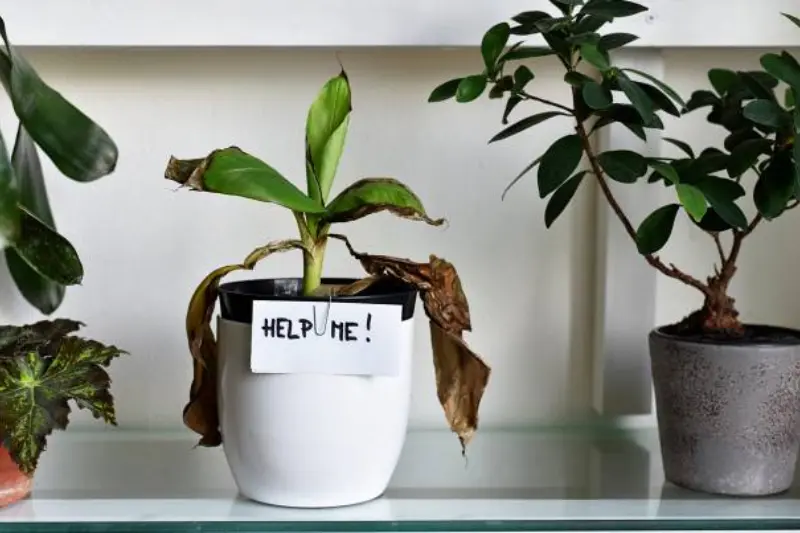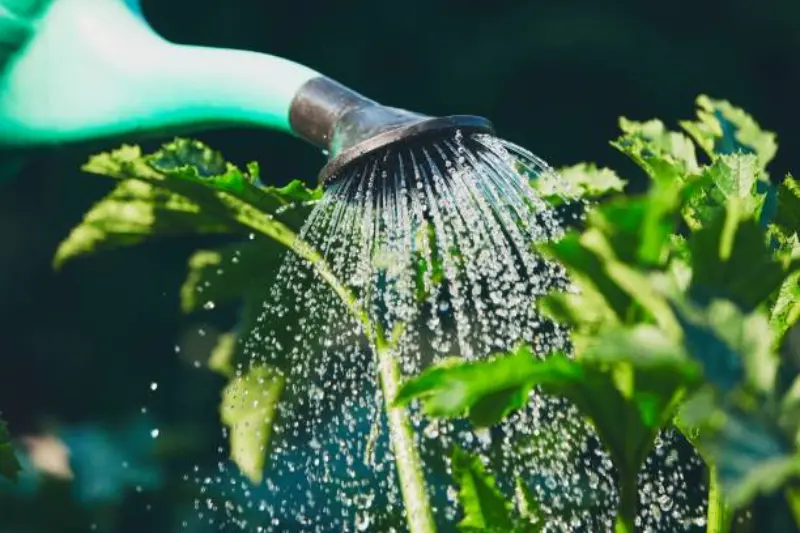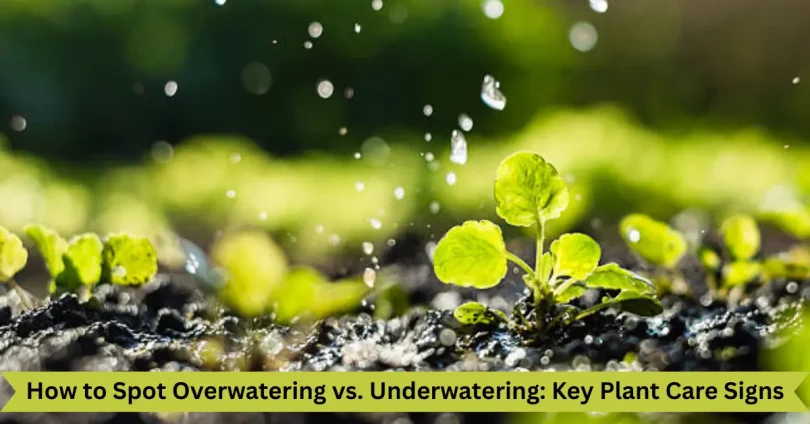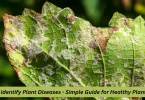Introduction
If your plants are looking a little sad lately—droopy leaves, yellow spots, or dry edges—you might be wondering what’s going wrong. The answer is often in the watering. Giving too much or too little water can both harm your plants, but the symptoms can look surprisingly similar.
In this post, we’ll help you understand how to spot overwatering vs. underwatering: key plant care signs that every plant parent should know. Whether you’re a beginner or have a house full of greenery, knowing the difference can save your plants and help them grow healthy and strong.
What Are Signs of Overwatering and Underwatering?

Watering is one of the most important parts of plant care—but it’s also one of the most common areas where things can go wrong. Overwatering means your plant is getting more water than it can handle, while underwatering means it’s not getting enough. Both situations can stress your plant, slow its growth, or even lead to serious damage over time.
The tricky part? The signs of overwatering and underwatering can look very similar. That’s why it’s important to know what to look for so you can tell the difference and take the right action.
- Overwatering usually leads to yellowing leaves, soft stems, and soggy soil. The roots may start to rot because they can’t get enough oxygen.
- Underwatering often causes dry, crispy leaves, soil that pulls away from the pot, and leaves that droop or curl up from lack of moisture.
By paying attention to these symptoms and checking the soil regularly, you can avoid common mistakes and help your plants thrive.
Why This Is Important?
Understanding the difference between overwatering and underwatering is key to healthy plant care. Here’s why it matters more than you might think.
Helps Prevent Plant Stress and Damage
- Early detection saves your plant
Spotting the signs early can help you fix the issue before it causes long-term damage. Plants under stress are more likely to wilt, drop leaves, or stop growing. - Reduces risk of disease
Overwatered plants are prone to root rot and fungal infections. Keeping watering balanced lowers the risk of serious plant diseases. - Encourages strong root systems
Consistent, proper watering helps roots grow deep and strong. This leads to a healthier and more resilient plant overall.
Saves Time, Effort, and Money
- Fewer replacements needed
Avoiding watering mistakes means your plants live longer. You won’t have to keep replacing dead or struggling plants. - Reduces wasted water and soil
Overwatering often leads to water runoff and soggy soil that needs to be changed. Knowing what your plant really needs helps avoid waste. - Minimizes constant guesswork
When you learn to spot the signs, you stop guessing. That means less trial and error and more confident plant care.
Supports Healthy, Thriving Plants
- Improves growth and appearance
Well-watered plants grow faster, stay greener, and look healthier. You’ll notice fuller leaves and better color. - Boosts flowering and fruiting
Many plants only flower or produce fruit when they’re well-cared for. Proper watering plays a big role in that process. - Builds a better plant care routine
Learning how to water correctly helps you create a routine that works. It keeps your plant collection low-stress and high-reward.
Step-by-Step Guide: Signs of Overwatering and Underwatering

Figuring out whether your plant is getting too much or too little water can be tricky. Follow these steps to correctly identify the problem and take action.
Step 1: Check the Soil Moisture
- Insert your finger into the soil up to 1–2 inches deep.
If the soil feels soggy or wet, it’s likely overwatered. If it’s completely dry and crumbly, underwatering is the issue. - Look for soil pulling away from the pot edges.
This usually means the soil is too dry and shrinking—common in underwatered plants. - Use a moisture meter for accuracy.
These tools give a quick reading of how wet or dry the soil is, taking out the guesswork.
Step 2: Examine the Leaves
- Yellowing leaves can point to overwatering.
Especially if the yellowing starts from the lower part of the plant and the leaves feel soft. - Crispy or browning edges suggest underwatering.
The plant is drying out and not getting enough moisture to support healthy leaves. - Drooping leaves can go either way.
If the soil is wet, it’s from overwatering. If dry, it’s from underwatering. Always check soil to confirm.
Step 3: Inspect the Stems and Roots (if needed)
- Soft or mushy stems are a sign of rot from overwatering.
This indicates that water has been sitting too long at the root level. - Dry, brittle stems point to underwatering.
The plant is struggling to transport water and nutrients from the roots. - Check the roots if repotting.
Brown, black, or foul-smelling roots mean root rot (overwatering). Dry and thin roots may suggest underwatering.
Step 4: Observe Soil Conditions Over Time
- Track how long the soil stays wet.
If it’s still wet days after watering, you’re likely overwatering or using poor-draining soil. - Notice how quickly the soil dries out.
If the soil becomes dry within a day or two, the plant might be thirsty or the pot is too exposed to heat. - Adjust your watering schedule accordingly.
Water only when the top inch or two of soil is dry—don’t water just because it’s “watering day.”
Step 5: Look for Additional Clues
- Fungus gnats or mold on soil surface?
These pests thrive in overly wet conditions—another sign of overwatering. - Soil cracked and compacted?
That’s a strong sign your plant isn’t getting enough water, and it may be time for a deep soak. - Growth slowed or stopped?
Both over- and underwatering can slow growth. The right fix depends on the moisture condition of the soil.
Step 6: Make the Right Fix
- For overwatered plants:
Stop watering immediately, improve drainage, and remove any rotting roots if needed. Allow the soil to dry out before watering again. - For underwatered plants:
Water deeply so the moisture reaches the root zone. If the soil is very dry, water slowly in stages to avoid runoff.
Advantages and Disadvantages of Spotting Overwatering and Underwatering Signs
Understanding how to identify watering issues has many benefits, but there are also a few challenges to be aware of, especially for beginners.
| Advantages | Disadvantages |
| Healthier Plants Spotting watering issues early allows you to fix the problem before serious damage occurs. This leads to stronger roots, better growth, and a more vibrant appearance. | Symptoms Can Be Similar Both overwatering and underwatering can cause drooping or yellowing leaves. Without checking the soil, it’s easy to misdiagnose the issue. |
| Improved Confidence in Plant Care Understanding the signs reduces guesswork in watering decisions. It helps you feel more in control and less anxious about plant health. | Takes Practice to Master Reading plant signals correctly isn’t always easy for beginners. It often involves learning through trial and error. |
| Saves Time and Money Preventing plant decline reduces the need for repotting or replacing dead plants. You’ll also use less water, soil, and fertilizer over time. | Varies by Plant Type Some plants thrive on dry soil, while others need constant moisture. General watering advice doesn’t work for every species. |
| Better Growth and Appearance Plants receiving the right amount of water grow faster and look more lush. Proper hydration improves leaf color, shape, and overall beauty. | Environmental Factors Can Mislead Temperature, light, and humidity changes affect how fast soil dries. These factors can confuse even experienced plant owners. |
| Helps Build a Consistent Care Routine Recognizing your plant’s watering needs makes it easier to stick to a schedule. This consistency reduces stress for both you and your plants. | Can Lead to Over-Correction Misreading the signs may cause you to switch watering habits too quickly. This can shock the plant and worsen its condition. |
Common FAQs About Overwatering and Underwatering
How do I know if my plant is overwatered or underwatered?
Check the soil first. If it’s very wet and the leaves are yellow or soft, it’s likely overwatered. If the soil is dry and leaves are crispy or droopy, it’s probably underwatered.
Can overwatering kill my plants?
Yes, too much water can cause root rot, which can kill the plant if not fixed quickly. It’s important to let the soil dry out before watering again.
How often should I water my plants?
It depends on the plant type, pot size, and environment. A good rule is to water only when the top 1-2 inches of soil feel dry.
What should I do if I overwater my plant?
Stop watering and let the soil dry out. If needed, repot the plant and trim any rotten roots to help it recover.
What happens if I underwater my plant?
The plant will get dry and wilt, and leaves may turn brown and crispy. Water it deeply as soon as you notice these signs to help it bounce back.
Can I use a moisture meter to help?
Yes! A moisture meter can help you check the soil’s moisture level more accurately, so you don’t have to guess when to water.
Why do some plants need more water than others?
Different plants come from different climates. Some like lots of moisture, while others prefer dry soil. Always check your plant’s specific watering needs.
Can weather affect how often I should water?
Absolutely. Hot, dry weather means plants need water more often. In cooler or more humid weather, they need less.
Conclusion
Knowing how to spot the signs of overwatering and underwatering is key to keeping your plants happy and healthy. By checking your soil and watching your plant’s leaves and stems, you can fix problems before they get serious. Remember, every plant is different, so pay attention and adjust your watering routine as needed. With a little care and attention, your plants will thrive!
Bonus Points: Extra Tips for Watering Your Plants Right
- Use pots with drainage holes
This helps prevent water from sitting at the bottom and causing root rot. - Water in the morning
Watering early helps plants absorb moisture before the heat of the day evaporates it. - Avoid watering the leaves
Focus on watering the soil and roots to reduce the chance of fungal diseases. - Learn about your plant’s specific needs
Some plants like their soil to dry out completely, while others prefer to stay moist—research your plant species for best results. - Group plants with similar water needs together
This makes watering easier and helps avoid overwatering or underwatering certain plants.





[…] How to Spot Overwatering vs Underwatering: Key Plant Care Signs […]
[…] How to Spot Overwatering vs Underwatering: Key Plant Care Signs […]
[…] How to Spot Overwatering vs Underwatering: Key Plant Care Signs […]